Globe artichoke
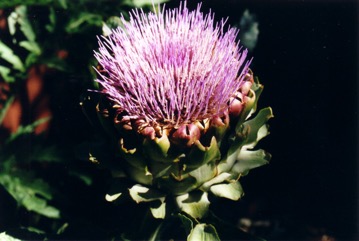
A Mediterranean plant. It can be grown in the highlands in the tropics. It suits drier areas. It prefers deep, rich, alkaline soils in an open sunny position. It is frost resistant but drought tender. It suits plant hardiness zones 6-11.
Also known as:
Alcachofera, Alcachofra, Archiciocca, Artichaut, Artičoka, Carciofo, Chao zian ji, Chousen azami, Enginar, Hathichak, Hathichoke, Kenchofe, Yabani enginar, Yang ji
Edible Portion
- Leaves, Flowers, Vegetable, Stems
Where does Globe artichoke grow?
Found in: Africa, Asia, Australia, Belgium, Central America, China, Cuba, Cyprus, Dominican Republic, East Africa, Egypt, Ethiopia, Europe, France, Greece, Haiti, India, Indochina, Indonesia, Italy, Macedonia, Malta, Mediterranean, Mexico, North Africa, North America, Pacific, Papua New Guinea, PNG, Philippines, Portugal, SE Asia, Slovenia, South Africa, Southern Africa, Spain, Tasmania, Turkey, United States
Notes: The leaves are used in medicine for treatment of bile/liver conditions. There are about 10 Cynara species.
Status: It is a commercially cultivated vegetable. Not commonly seen in Papua New Guinea although apparently gaining some acceptance in some areas.
Growing Globe artichoke
Cultivation: Plants can be grown by seed or suckers. It is best to grow the seeds in a nursery and then transplant them. It can also be grown by dividing up a mature clump. Suckers and offshoots produce uniform crops. Seedlings are transplanted when 15 cm high. A spacing of 120-200 cm is suitable.
Edible Uses: The fleshy bracts of the flower and the base of the flower head are boiled and eaten. They can be used in soups. They can be eaten raw, boiled, steamed, baked, fried, stuffed or marinated. The small side shoots are pickled, preserved in oil, or used in soups and stews. (To stop the cut artichoke turning brown in air, they can be dipped in lemon juice.) The tender inner portion of the flower stalk can be eaten raw or cooked.
Production: Plants from seeds produce flowers after 240 days and plants from suckers flower earlier. The flower buds can be produced over a 2 or 3 year period. The buds are harvested when full size but before the bracts open.
Nutrition Info
per 100g edible portion| Edible Part | Energy (kcal) | Protein (g) | Iron (mg) | Vitamin A (ug) | Vitamin c (mg) | Zinc (mg) | % Water |
|---|---|---|---|---|---|---|---|
| Boiled- heart of bud/base of Leaves | 15 | 1.1 | 0.5 | 90 | 8 | 0.5 | 84.4 |
| Stem - raw + edible part of bracts/Flower | 47 | 3.3 | 1.3 | 18 | 12 | 0.5 | 84.5 |
| Boiled Stem + edible part of bracts/Flower | 50 | 3.5 | 1.3 | 177 | 10 | 0.5 | 84 |
Globe artichoke Photos

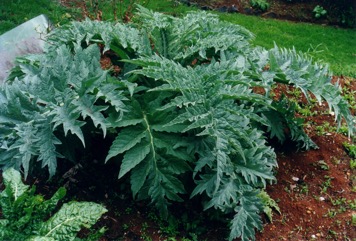
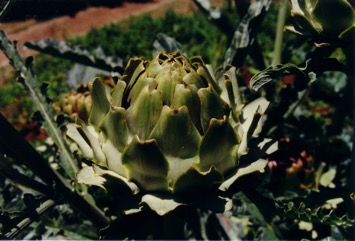
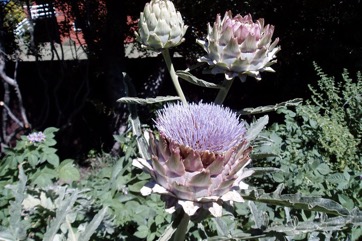
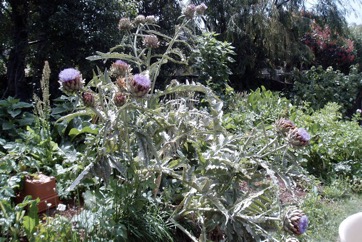
References
Ambasta, S.P. (Ed.), 2000, The Useful Plants of India. CSIR India. p 156
Bianchini, F., Corbetta, F., and Pistoia, M., 1975, Fruits of the Earth. Cassell. p 60
Blamey, M and Grey-Wilson, C., 2005, Wild flowers of the Mediterranean. A & C Black London. p 454
Bodkin, F., 1991, Encyclopedia Botanica. Cornstalk publishing, p 314
Bremness, L., 1994, Herbs. Collins Eyewitness Handbooks. Harper Collins. p 162
Brickell, C. (Ed.), 1999, The Royal Horticultural Society A-Z Encyclopedia of Garden Plants. Convent Garden Books. p 331
Brouk, B., 1975, Plants Consumed by Man. Academic Press, London. p 68
Brown, D., 2002, The Royal Horticultural Society encyclopedia of Herbs and their uses. DK Books. p 188 (As Cynara cardunculus)
Burkill, I.H., 1966, A Dictionary of the Economic Products of the Malay Peninsula. Ministry of Agriculture and Cooperatives, Kuala Lumpur, Malaysia. Vol 1 (A-H) p 739
Cheifetz, A., (ed), 1999, 500 popular vegetables, herbs, fruits and nuts for Australian Gardeners. Random House p 62
Ciftcioglu, C. G., 2015, Sustainable wild-collection of medicinal and edible plants in Lefke region of North Cyprus. Agroforest Syst. Springer
Della, A., et al, 2006, An ethnobotanical survey of wild edible plants of Paphos and Larnaca countryside of Cyprus. J. Ethnobiol. Ethnomed. 2:34
Ertug, F., 2004, Wild Edible Plants of the Bodrum Area. (Mugla, Turkey). Turk. J. Bot. 28 (2004): 161-174
Facciola, S., 1998, Cornucopia 2: a Source Book of Edible Plants. Kampong Publications, p 37
French, B.R., 1986, Food Plants of Papua New Guinea, A Compendium. Asia Pacific Science Foundation p 138
Hadfield, J., 2001, The A-Z of Vegetable Gardening in South Africa. Struik p 73
Heyne, K. 1927, p 1446
Hibbert, M., 2002, The Aussie Plant Finder 2002, Florilegium. p 79
Hussey, B.M.J., Keighery, G.J., Cousens, R.D., Dodd, J., Lloyd, S.G., 1997, Western Weeds. A guide to the weeds of Western Australia. Plant Protection Society of Western Australia. p 96
Hu, Shiu-ying, 2005, Food Plants of China. The Chinese University Press. p 727
Huxley, A. (Ed.), 1977, The Encyclopedia of the Plant Kingdom. Chartweil Books. p 156
Jardin, C., 1970, List of Foods Used In Africa, FAO Nutrition Information Document Series No 2.p 73
Joyce, D., 1998, The Garden Plant Selector. Ryland, Peters and Small. p 218
Kayabasi, N. P., et al, 2018, Wild edible plants and their traditional use in the human nutrition in Manyas (Turkey). Indian Journal of Traditional Knowledge. Vol. 17(2), April 2018, pp 299-306
Kays, S. J., and Dias, J. C. S., 1995, Common Names of Commercially Cultivated Vegetables of the World in 15 languages. Economic Botany, Vol. 49, No. 2, pp. 115-152
Kiple, K.F. & Ornelas, K.C., (eds), 2000, The Cambridge World History of Food. CUP p 1722
Lazarides, M. & Hince, B., 1993, Handbook of Economic Plants of Australia, CSIRO. p 72
Macmillan, H.F. (Revised Barlow, H.S., et al), 1991, Tropical Planting and Gardening. Sixth edition. Malayan Nature Society. Kuala Lumpur. p 359
Martin, F.W. & Ruberte, R.M., 1979, Edible Leaves of the Tropics. Antillian College Press, Mayaguez, Puerto Rico. p 184
Miguel, E., et al, 1989, A checklist of the cultivated plants of Cuba. Kulturpflanze 37. 1989, 211-357
Molla, A., Ethiopian Plant Names. http://www.ethiopic.com/aplants.htm
Morley, B. & Everard, B., 1970, Wild Flowers of the World. Ebury press. Plate 40
Paczkowska, G. & Chapman, A.R., 2000, The Western Australian Flora. A Descriptive Catalogue. Western Australian Herbarium. p 161
Plants for a Future database, The Field, Penpol, Lostwithiel, Cornwall, PL22 0NG, UK. http://www.scs.leeds.ac.uk/pfaf/
Purseglove, J.W., 1968, Tropical Crops Dicotyledons, Longmans. p 53
Ruiters-Welcome, A. K., 2019, Food plants of southern Africa. Ph.D. thesis. Univ. of Johannesburg p 34
Schneider, E., 2001, Vegetables from Amaranth to Zucchini: The essential reference. HarperCollins. p 19
Sharma, B.B., 2005, Growing fruits and vegetables. Publications Division. Ministry of Information and broadcasting. India. p 204
Sinclair, V., 1992, The Floral Charm of Cyprus. Interworld Publications. p 105
Small, E., 2009, Top 100 Food Plants. The world's most important culinary crops. NRC Research Press. p 92
Smith, P.M., 1979, Artichoke, in Simmonds, N.W., (ed), Crop Plant Evolution. Longmans. London. p 305
Sp. pl. 2:827. 1753
Terra, G.J.A., 1973, Tropical Vegetables. Communication 54e Royal Tropical Institute, Amsterdam, p 43
Tronickova, E. & Krejcova, Z., 1987, Ortaggi, Instituto Geografico de Agostini, Cecoslovacchia. p 182
van Wyk, B., 2005, Food Plants of the World. An illustrated guide. Timber press. p 170